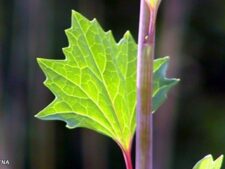
PALE INDIAN PLANTAIN
Arnoglossum atriplicifolia
SUNFLOWER FAMILY (Asteraceae)
 Identification
Identification
- Flowering time - June, July, August, September
- Rare at NW; uncommon at FF in savanna restorations
- Tall plant with smooth often purplish stem
- Large maple-like lower leaves with palmate veins
- Flat-topped cluster of pale green flower heads
This distinctive native perennial may be from 3-8 feet tall (A). It has a single, smooth, often purplish stem with a thin, whitish coating. Near its top the stem branches into an open flat-topped cluster (corymb) of up to 100+ flower heads (B). Large, basal, palmately veined, maple-like leaves, up to 12 inches long (D,E) are replaced by progressively smaller ones further up the stem, the uppermost reduced to small bracts (B). Each flower head is composed of up to 15 individual flowers enclosed by 5 tubular light green bracts with darker vertical banding. Inside are 5 inconspicuous white, greenish white or light purple disk florets less than 1/4 inch in diameter, their tips barely emerging above the bracts (C).
Most often found in open woodlands, Pale Indian Plantain flowers from June through September. It is rare at Neale Woods. Formerly hard find in Fontenelle Forest it has become fairly common in the upland savanna restorations as the tree canopy has become more open.
The closely related prairie plant, Tuberous Indian Plantain (Arnoglossum plantagineum), collected in Fontenelle Forest in the 1950’s but not recently seen, has a prominently grooved stem and oval leaves with parallel veins.
The content of NatureSearch is provided by dedicated volunteer Naturalists of Fontenelle Forest who strive to provide the most accurate information available. Contributors of the images retain their copyrights. The point of contact for this page is: Neal Ratzlaff.




